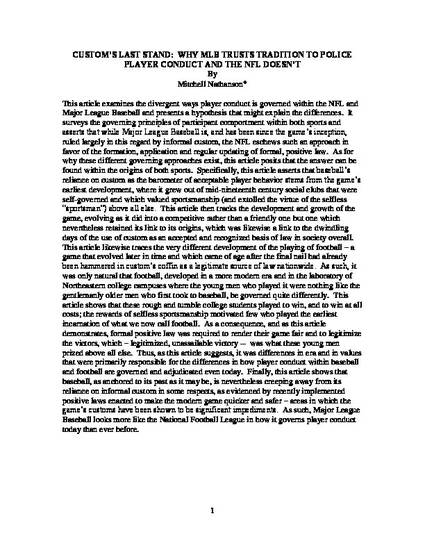
Article
CUSTOM’S LAST STAND: WHY MLB TRUSTS TRADITION TO POLICE PLAYER CONDUCT AND THE NFL DOESN’T
University of Texas Review of Entertainment and Sports Law,
(2017)
Abstract
This article examines the divergent ways player conduct is governed within the NFL and Major League Baseball and presents a hypothesis that might explain the differences. It surveys the governing principles of participant comportment within both sports and asserts that while Major League Baseball is, and has been since the game’s inception, ruled largely in this regard by informal custom, the NFL eschews such an approach in favor of the formation, application and regular updating of formal, positive law. As for why these different governing approaches exist, this article posits that the answer can be found within the origins of both sports. Specifically, this article asserts that baseball’s reliance on custom as the barometer of acceptable player behavior stems from the game’s earliest development, where it grew out of mid-nineteenth century social clubs that were self-governed and which valued sportsmanship (and extolled the virtue of the selfless “sportsman”) above all else. This article then tracks the development and growth of the game, evolving as it did into a competitive rather than a friendly one but one which nevertheless retained its link to its origins, which was likewise a link to the dwindling days of the use of custom as an accepted and recognized basis of law in society overall. This article likewise traces the very different development of the playing of football – a game that evolved later in time and which came of age after the final nail had already been hammered in custom’s coffin as a legitimate source of law nationwide. As such, it was only natural that football, developed in a more modern era and in the laboratory of Northeastern college campuses where the young men who played it were nothing like the gentlemanly older men who first took to baseball, be governed quite differently. This article shows that these rough and tumble college students played to win, and to win at all costs; the rewards of selfless sportsmanship motivated few who played the earliest incarnation of what we now call football. As a consequence, and as this article demonstrates, formal positive law was required to render their game fair and to legitimize the victors, which – legitimized, unassailable victory -- was what these young men prized above all else. Thus, as this article suggests, it was differences in era and in values that were primarily responsible for the differences in how player conduct within baseball and football are governed and adjudicated even today. Finally, this article shows that baseball, as anchored to its past as it may be, is nevertheless creeping away from its reliance on informal custom in some respects, as evidenced by recently implemented positive laws enacted to make the modern game quicker and safer – areas in which the game’s customs have been shown to be significant impediments. As such, Major League Baseball looks more like the National Football League in how it governs player conduct today than ever before.
Keywords
- baseball,
- football,
- custom,
- law,
- positive law
Disciplines
- Law and
- Sports Studies
Publication Date
Spring 2017
Citation Information
Mitchell J Nathanson. "CUSTOM’S LAST STAND: WHY MLB TRUSTS TRADITION TO POLICE PLAYER CONDUCT AND THE NFL DOESN’T" University of Texas Review of Entertainment and Sports Law, (2017) Available at: http://works.bepress.com/mitchell_nathanson/32/
